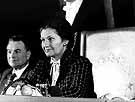
|
|
|

|

|

|

|
|
Click on an image to see a larger, more detailed picture.
|
|
|
|
|
| EPILOGUE: The Aftermath |

|
pg. 693 |

|
|
|
|
| |
 A 1996 auction in Vienna was organized around "heirless" artworks plundered by the Nazis from Jewish families. About 8000 objects, including Old Masters paintings, were auctioned, with proceeds going to needy Austrian-Jewish Holocaust survivors.
A 1996 auction in Vienna was organized around "heirless" artworks plundered by the Nazis from Jewish families. About 8000 objects, including Old Masters paintings, were auctioned, with proceeds going to needy Austrian-Jewish Holocaust survivors.
Photo: Reuters/Jacqueline Godany/Archive Photos
|
|
The restitution effort is a noble one that seeks to bring at least a modicum of closure to the Holocaust. Unfortunately, the Holocaust eludes closure, for the inventory of its damages shows that there are always more, many more. For generations to come, undeserving people in Europe and around the world will be the willful or unwitting beneficiaries of Nazi theft from Jews and also from other persons and institutions in Nazi-occupied countries. For example, the Nazis stole huge amounts of monetary gold, often stockpiling it in the banks of neutral countries such as Turkey, Spain, Portugal, and Sweden, as well as Switzerland. The "Nazi gold" also included substantial quantities of nonmonetary gold--dental fillings and crowns, for instance, that were "harvested" from the Nazis' death-camp victims. Those assets did not lie dormant. They created unearned benefits that went here or there but not to the rightful owners. Property owned by Jewish groups--synagogues and schools, for instance--constitutes another area where theft took place and the issues of restitution loom large. This is partly true because only vestiges of those communities remain, especially in Poland and other Eastern European countries that experienced not only Nazi occupation but Soviet domination and Communist regimes during the Cold War. Then, as the story of a Jewish woman named Marta Drucker Cornell illustrates, there are huge problems to tackle that involve insurance. In 1945 Marta Drucker was 17. Except for her 80-year-old grandmother, she was the only survivor of her middle-class Czech family. After more than three years in Nazi concentration camps, she had her life but little else. One of her few possessions was a postcard-sized piece of paper on which her father, Dr. Leopold Drucker, had written numbers whose meaning she did not know. With the help of a friend of her father's--he turned out to be Dr. Drucker's insurance agent--she learned that the numbers referred to her father's life insurance policies. Much as Estelle Sapir tried to retrieve her family's money from Swiss banks, Marta Drucker worked to get her family's insurance monies. The responses she got from the insurance firms were no different from the ones Sapir received from the banks.
|
 Empowered at last: In 1959 Simone Veil, a French Jew and a survivor of Auschwitz, became president of the European Council.
Empowered at last: In 1959 Simone Veil, a French Jew and a survivor of Auschwitz, became president of the European Council.
Photo: SYddeutscher Verlag Bilderdienst
|
|

|

|

|

|
 September 9, 1997: The London-based Holocaust Educational Trust reports that British-based banks may be holding as much as $1.1 billion in dormant accounts opened by victims of the Holocaust.
September 9, 1997: The London-based Holocaust Educational Trust reports that British-based banks may be holding as much as $1.1 billion in dormant accounts opened by victims of the Holocaust.
|
 October 1997: Accused former Nazi collaborator Maurice Papon goes on trial in France, for the deportations and subsequent deaths of hundreds of French, including children.
October 1997: Accused former Nazi collaborator Maurice Papon goes on trial in France, for the deportations and subsequent deaths of hundreds of French, including children.
|
 November 1, 1997: Swiss documents are made public, showing that a U.S. bank, National City (later Citibank), knowingly accepted about $30 million of looted Nazi gold as collateral for a loan to Spain. National City, working with the approval of the U.S. Treasury Department, accepted the gold after it had been laundered by Swiss banks; See 1951.
November 1, 1997: Swiss documents are made public, showing that a U.S. bank, National City (later Citibank), knowingly accepted about $30 million of looted Nazi gold as collateral for a loan to Spain. National City, working with the approval of the U.S. Treasury Department, accepted the gold after it had been laundered by Swiss banks; See 1951.
|
|
|
|
|
| EPILOGUE: The Aftermath |

|
pg. 693 |

|
|
The Holocaust Chronicle
© 2009 Publications International, Ltd.
|
|
